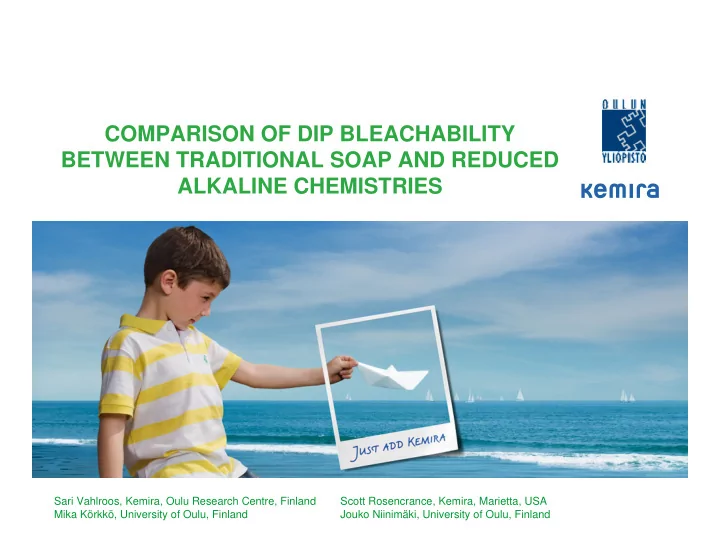

COMPARISON OF DIP BLEACHABILITY BETWEEN TRADITIONAL SOAP AND REDUCED ALKALINE CHEMISTRIES Sari Vahlroos, Kemira, Oulu Research Centre, Finland Scott Rosencrance, Kemira, Marietta, USA Mika Körkkö, University of Oulu, Finland Jouko Niinimäki, University of Oulu, Finland
Introduction Profitability Environmental safety Continuous improvement in quality Debasement of the raw material quality REDUCED ALKALINE / NEUTRAL DEINKING lower total the lack of chemical cost ink release lower COD increased ink release fragmentation ability to remove alkaline sensitive printing inks, yield like flexo. reduced ink removal improved stickies efficiency control Sari Vahlroos 26.9.2007 2
Objective of the study � To evaluate the bleaching performance for pulps produced via both a reduced alkaline chemistry and a traditional alkaline chemistry. Sari Vahlroos 26.9.2007 3
Experimental Papers & deinking chemicals � The furnish composition used in this study consisted of 50% of newspapers (ONP) and 50% of magazines (OMG). The OMG paper was 50% SC (super calandered) and 50% LWC (light weight coated) Deinking chemical dosages, kg/t Alkaline soap Reduced alkaline chemistry Lionsurf chemistry Sodium hydroxide 10 - Sodium silicate 10 10 Soap 5 - Hydrogen peroxide 6 - Lionsurf 305 - 0.75 Lionsurf 564 - 0.75 Sari Vahlroos 26.9.2007 4
Experimental Bleaching chemicals � Alkaline or reduced alkaline deinked pulp was bleached with peroxide and dithionite (P+Y). Peroxide bleaching Bleaching chemical dosages, kg/t Alkaline soap Reduced alkaline chemistry Lionsurf chemistry Hydrogen peroxide 20 20 3 4 Sodium hydroxide Sodium silicate 10 10 Dithionite bleaching: pH 7 Dosage 8 kg/t Sari Vahlroos 26.9.2007 5
Experimental Deinking; pilot equipment Pulper Flotation Wire press pulp tank onp water tank Sample point Sari Vahlroos 26.9.2007 6
Experimental Deinking; pilot equipments Pulper Flotation Wire press pulp tank � 20 minutes � 16% consistency � batches of 33 kg of o.d. pulp. � 45°C temperature water tank Sari Vahlroos 26.9.2007 7
Experimental Deinking; pilot equipments Pulper Flotation Wire press pulp tank onp � Diluted to 2% consistency with equilibrated process water � Pumped through a screen basket with perforation of 1.5 mm. � Following screening, the consistency was adjusted to 1% in preparation to feed the flotation stage. water tank Sari Vahlroos 26.9.2007 8
Experimental Deinking; pilot equipments Pulper Flotation � The flotation cell is a model of Metso and Wire press consists of four sectors. � The air flow to flotation was 80 L/min which resulted in an air/stock ratio of 110%. pulp tank onp � The reject were pressed and the filtrate was circulated back to process water tank Sari Vahlroos 26.9.2007 9
Experimental Deinking; pilot equipments Pulper Flotation Wire press pulp tank onp � The accepts of flotation were sent to a wire press. After the wire press, the consistency of the pulp was about 20%. This stock was then utilized for laboratory scale bleaching studies. water tank Sari Vahlroos 26.9.2007 10
Experimental Lab bleaching � The carryover of residual peroxide was prevented by dilution and thickening back to 4% consistency prior to dithionite bleaching � The peroxide post-bleaching was performed at 90°C, for 40 min and at 10% consistency. � The dithionite bleaching was performed at 60°C, for 30 min and at 4% consistency. Sari Vahlroos 26.9.2007 11
Results Deinking Yield and TOC � The flotation pH with alkaline and reduced alkaline chemistry was 9.0 and 8.0, respectively. Yield over flotation, % Alkaline soap 82.2 chemistry Reduced alkaline 83.1 Lionsurf chemistry TOC, mg/l 600 An equally long trial and the same 500 water consumption gave almost double the Total Organic Carbon 400 (TOC) load for alkaline deinking than 300 reduced alkaline deinking. Alkaline deinking 200 Reduced alkaline 100 deinking 0 Sari Vahlroos 26.9.2007 12
Results Deinking Brightness Brightness, ISO% 70 65 alkaline 4 ISO% 60 reduced alkaline 55 50 45 Flotation feed Flotation accept Wire press outlet Alkaline Reduced alkaline Sari Vahlroos 26.9.2007 13
Results Deinking Ink removal Residual ink, ppm 1200 1000 800 reduced alkaline 600 400 alkaline 200 0 Flotation feed Flotation accept Wire press outlet Alkaline Reduced alkaline Sari Vahlroos 26.9.2007 14
Results Deinking b*-value + b = yellow b* C/2 5 ash removing 4 Ink and ash removing 3 2 1 0 Flotation feed Flotation accept Wire press outlet Alkaline Reduced alkaline Sari Vahlroos 26.9.2007 15
Results Bleaching Peroxide Reduced alkaline bleaching deinking + bleaching Alkaline bleaching pulping deinking + bleaching 0 0.2 0.4 0.6 0.8 1 1.2 1.4 NaOH dosage, % Intial pH Final pH Residual peroxide % of the dosage in peroxide bleaching in peroxide bleaching Alkaline 10 8.9 44 Reduced alkaline 10 7.6 55 Sari Vahlroos 26.9.2007 16
Results Bleaching Brightness Brightness, ISO% 70 68 66 alkaline 64 reduced 62 alkaline 60 58 56 Wire press outlet peroxide bleached peroxide + dithionite bleached Alkaline Reduced alkaline Sari Vahlroos 26.9.2007 17
Conclusions � Monitoring through the whole process is very important when reduced alkaline chemistry is compared to the alkaline chemistry: Waters: � Lower TOC-load Deinking: � Equal ink removal Bleaching: � more responsive to the post-bleaching chemicals because peroxide was not used in pulper. � Post-bleaching the pulps, obtained from both a traditional alkaline process and a reduced alkaline process resulted in the same residual ink and brightness values. Sari Vahlroos 26.9.2007 18
Recommend
More recommend